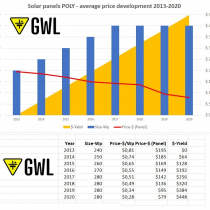Blog - Solar panels

The Price Development of the Poly Solar Panels 2013-2020
The graph shows the price and size development of the 60 cell Poly solar panels from 2013 to 2020.
- The price of typical solar panel [red line]: in 2013/6 #1) the most sold size was 240Wp with average price of $195, in 2020/6 the average size is 280Wp and the average price is $79.
- Size increase [blue bars]: the size of the solar panels was increasing every year by 10Wp from 2013, to 2017. Since 2017 the average Wp is keeps at a 280Wp for the 60-cell poly panel.
- Price per Wp [not in the graph]: the price per Wp dropped from $0.81 in 2013 to $0.28 in 2020.
- Solar yield [yellow area]: if you bought a 240Wp panel in 2013, the panel would produce some 192Wp of energy (at 80% level). For an average yearly sunshine of 1500 hours, you would get 288 kWh #2) of solar energy from this panel. If we say 1 kWh is priced at USD $0.22 (CZK5.00), the financial benefit of the solar yield corresponds to $64 per year. Since 2013 till 2020 the solar panel would earn $448 for you. #3)
Summary: The price of the solar panels dropped significantly in 7 years, however still, delaying in running your solar installation makes you lose money. Even though the price of the solar panels dropped over the years, the solar yield from the installation not only pays the price of the original panel, but brings also additional profit.
Do not wait any day to make your own energy with solar panels from GWL.
Notes
#1) The average price is based on the monthly sales in the peak months of 6 and 7 of each year. The average price includes both retail sales price and volume discount pricing.
#2) This calculation is based on the average sunshine energy typical in central Europe: 1000 W/m2 and 1500 hrs of sunshine. In the south of Europe, you will get significantly better yields, while in the north of Europe, you will get lower yields.
#3) This is a theoretical comparative calculation. In reality there would be additional costs associated with the installation: transport costs, mounting costs, the work-force costs, and the cost of the DC to AC inverters to produce the electricity in 230V AC format.

 English
English Česká republika
Česká republika Germany
Germany France
France España
España Italia
Italia Sverige
Sverige Polski
Polski Nederland
Nederland









